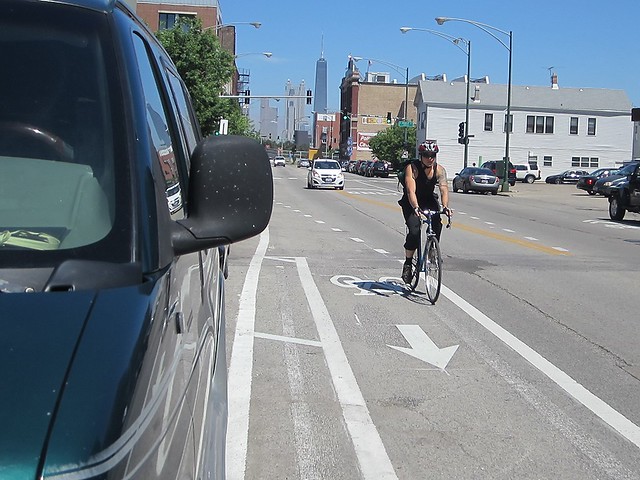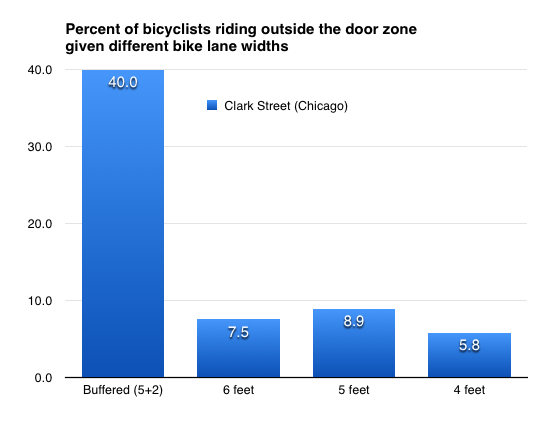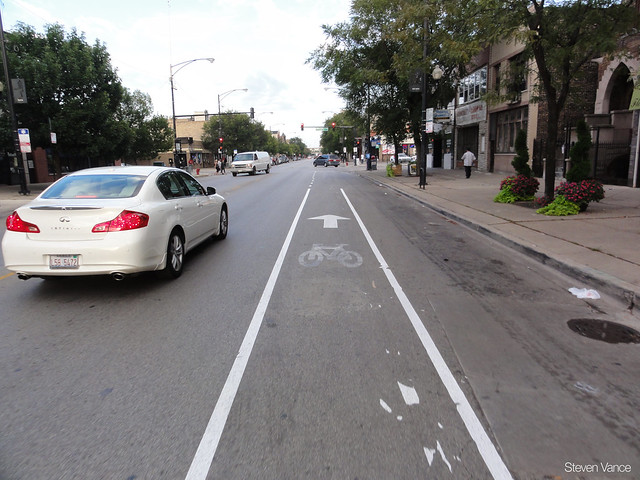
A new study has found that buffered bike lanes are better than conventional bike lanes when it comes to encouraging bicyclists to ride outside the door zone. The study draws its conclusion, in part, based on a test done with bike lanes in Chicago.
The study, recently published by the Transportation Research Board, concludes that wider but un-buffered bike lanes aren't necessarily better than narrower lanes in encouraging bicyclists to ride outside the door zone. If there's enough space to make a wider bike lane, the authors conclude, that extra space should be used to install a "narrower bicycle lane with a parking-side buffer," which "provides distinct advantages over a wider bike lane with no buffer."
Researchers reached their conclusions after observing thousands of cyclists using various bike lane configurations in Chicago and Cambridge, Massachusetts. On one Chicago street, for example, few bicyclists rode outside the door zone when the bike lane had no buffer, then after a two-foot buffer was striped, 40 percent rode outside the door zone:

That's because the door zone is four feet wide, and riding in the center of a six-foot-wide bike lane still doesn't give a cyclist enough clearance. The Chicago Bike Map itself recommends riding four feet away from parked cars, well outside the center line of even a six-foot-wide lane.
The on-street tests demonstrated that a six-foot-wide bike lane offers no advantage over one that’s five feet wide, or even four feet wide. Regardless of the width, bicyclists still ride in the center of the lane -- within the radius of a typical car door swinging open. Dooring crashes are common in urban areas like Chicago: In 2012, the last year for which data is available, 18 percent of reported bike crashes were doorings.
Chicago has several six-foot-wide bike lanes, including those on Elston from North Avenue into the far northwest side, Division Street through Wicker Park, and Milwaukee between Division and Elston. The on-road test, using temporary bike lane stripes, took place on Division Street near California, and on Clark Street near Schiller. Both streets did not have bike lanes before, and then bike lanes of varying widths were installed, culminating in the buffered lanes that exist at those locations today.
The researchers were studying different types of bike lanes, and how people use them, in order to refine recommendations in the American Association of State Highway and Transportation Officials' "Guide for the Development of Bicycle Facilities." The guide recommends five-foot-wide bike lanes and says four-foot-wide bike lanes can be used in other situations -- but it was based on trial and error, not scientific research.
While protected bike lanes weren't studied in this research, the authors' observations show how proximity to moving traffic contributes to doorings. For instance, the study concluded that, "as traffic volume increases, bicyclists move away from vehicles in the travel lane and position themselves closer to parked vehicles or the curb." Researchers observed the same response as truck traffic increased in the travel lane. This puts bicyclists in the door zone -- but with protected lanes, cyclists don't have to ride next to motor vehicle traffic, and this isn't a problem.
Chicago has been installing protected and buffered bike lanes across the city, and adding buffers to many conventional lanes. Those conversions are especially needed in locations where well-used conventional bike lanes have faded away, like along Division Street through Wicker Park and 18th Street through Pilsen. Whether those original bike lanes were six or five feet wide, their vanished lane markings now provide bicyclists with zero clues about how to keep comfortably away from moving traffic and outside the door zone.







